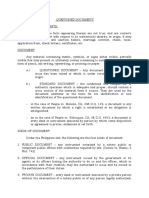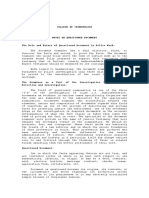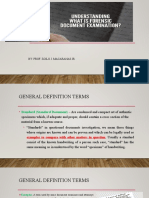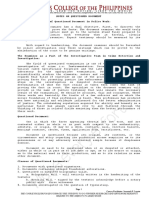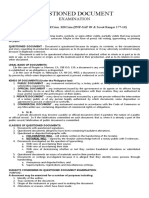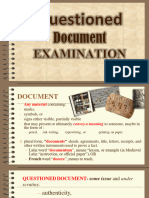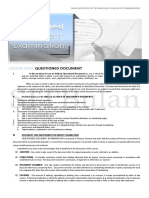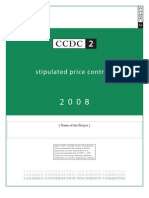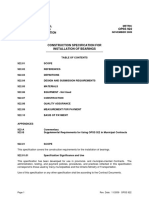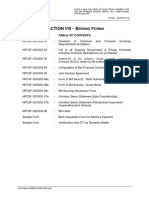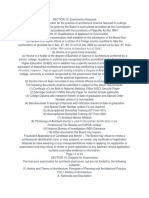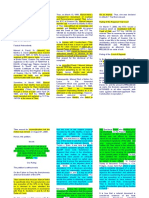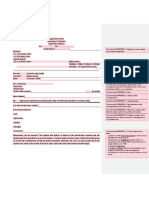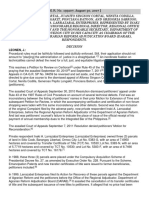Questioned Documents Examination
Uploaded by
ebuan8211Questioned Documents Examination
Uploaded by
ebuan8211QUESTIONED DOCUMENTS EXAMINATION
By: Aldrin R. Tarangco
1. QUESTIONED DOCUMENT - One in which the facts appearing therein are not
true, contested (either in the whole or in part) with respect to its: It may be a deed,
contract, will election ballots, marriage contract, check, visas, application form, check
writer, certificates, etc.
a. Authenticy b. Identity c. Origin.
2. DOCUMENT - Any material containing marks, symbols, or signs either visible,
partially visible that may present or ultimately convey a meaning to someone. Maybe
in the form of pencil, ink writing, typewriting, or printing on paper. -In the case of
People vs. Moreno, CA, 338 O.G. 119, a document is any written document by which
a right is established or an obligation is extinguished. An in the case of People vs.
Nillosquin, CA, 48 O.G. 4453, a document is every deed or instrument executed by
person by which some disposition or agreement is proved, evidenced or set forth.
3. QUESTIONED DOCUMENT - any document about which some issue has been
raised or which is under scrutiny, or of doubtful origin.
4. STANDARD DOCUMENT- are condensed and compact set of authentic specimen
which is adequate and proper, should contain a cross section of the material form it
source. They are used by the document examiner as the basis for his identification or
non-identification of the questioned document.
KINDS OF DOCUMENT
Under the Philippine Law, the following are the four kinds of document:
1. PUBLIC DOCUMENT- any instrument notarized by a notary public or competent
public official with solemnities required by law. (Cacnio vs. Baens, 5 Phil.742)
2. OFFICIAL DOCUMENT- any instrument issued by the government or its agents or
its officers having the authority to do so and the offices, which in accordance with
their creation, they are authorized to issue and be issued in the performance of their
duties.
3. PRIVATE DOCUMENT- every deed or instrument executed by a private person
without the intervention of a notary public or of any person legally authorized by
which documents, some disposition or agreement is proved evidenced or set forth.
(US vs. Orera, 11 Phil. 596).
Questioned Documents Examination
Page 1
4. COMMERCIAL DOCUMENT- any instrument executed in accordance with the
Code of Commerce or any Mercantile Law, containing disposition of commercial
rights or obligations.
N.B. A private document may become a public or official document when it partakes the
nature of a public or official record.
So if the falsifications committed on such document, that is, when it is already a part
of the public record, falsification of public or official document is committed.
However, if such private document is intended to become a part of the public record,
even though falsified prior thereto, falsification of a public document is committed.
WRITINGS, WHICH DO NOT CONSTITUTE DOCUMENTS:
Based on some Supreme Court Rulings
A draft of a Municipal Payroll, which is not yet approved by the proper authority.
(People vs. Camacho, 44 Phil. 484)
Mere blank forms of official documents, the spaces of which are not filled up. (People
vs. Santiago, CA, 48 O.G. 4558)
Pamphlets or books, which do not evidence any disposition or agreement, are not
documents but are mere merchandise. (People vs. Agnis 47, Phil. 945)
1. QUESTIONED - Any material, which some issue has been raised or which is under
scrutiny. QUESTIONED DOCUMENT - Document is questioned because its
origins, its contents, or the circumstance and story regarding its production arouse
suspicion as to its genuineness or it may adversely scrutinize simple because it
displeases someone.
2. DOCUMENT - is said to be questioned when it is disputed or attacked, either in
whole or in part as to its date or age, as to its source or origin, as to the material used
in their production, and as to its relation in some other document.
CLASSES OF QUESTIONED DOCUMENT:
1. Documents with questioned signatures.
2. Questioned documents alleged to have been containing fraudulent alterations.
3. Questioned or disputed holographic wills.
a. HOLOGRAPHIC WILL - will entirely written in the handwriting of the testator.
b. NOTARIAL WILL - signed by the testator acknowledge before a notary public
with 3 witnesses.
4. Documents investigated on the question of typewriting.
a. With a view of ascertaining their source.
b. With a view of ascertaining their date.
Questioned Documents Examination
Page 2
c. With a view of determining whether or not they contain fraudulent alterations of
substituted pages.
5. Questioned documents on issues of their age or date.
6. Questioned Documents on issues of materials used in their production.
7. Documents or writings investigated because it is alleged that they identify some
persons through handwriting.
a. Anonymous and disputed letters, and
b. Superscriptions, registrations and miscellaneous writings.
SUBJECTS CONSIDERED IN QUESTIONED DOCUMENT EXAMINATION:
A. Handwriting Examination
Examination of signatures and initials
Examination of anonymous letters
Hand printing examination
B. Typewriting Examination
C. Examination of inks
D. Erasures, alterations or obliterations, etc.
E. Counterfeiting
PURPOSES:
1. A document may be examined for a number of purposes including:
2. Identity of the author
3. True contents of the document
4. Origin of the instrument or paper used in making the document
5. Alterations or erasures, which have been made.
6. Authenticity of the document.
THE LOGICAL PROGRESS OF INQUIRY IN DOCUMENT EXAMINATION:
1. ASCERTAIN THE FACTS - to select “QUESTIONED”, “DENIED” or
“ADMITTED”, “ AUTHENTIC “, and “DOUBTFUL” documents.
2. ANALYZE THE DETAILS - Synthesize the elements, date and circumstances,
conditions, technical problems and the like.
3. QUALIFY THE CASE - Photo enlargements are always useful for demonstrating
the reasons on which the opinion is based, especially in Court.
Scientific Method in Questioned Document
A. Analysis - properties of characteristics observed or measured.
Questioned Documents Examination
Page 3
B. Comparison - Properties or characteristics of the unknown determined thought
analysis are now compared with the familiar or recorded properties of known
items.
C. Evaluation - Similarities or dissimilarities in properties or characteristics will each
have a certain value for identification, determined by its likelihood of occurrence.
CARE, HANDLING AND PRESERVATION OF DOCUMENTS
Do’s
1. Keep the documents unfolded in prospective envelopes.
2. Take disputed papers to Document Examiner’s Laboratory at the First Opportunity.
3. If storage is necessary, keep in dry place away from excessive heat strong light.
Don’ts
1. Do not handle disputed papers excessively or carry then in pocket for a long time.
2. Do not marked disputed documents (either by consciously writing instruments or
dividers.
3. Do not mutilate or damage by repeated refolding, creasing, cutting tearing or
punching for filing purposes.
4. Do not allow anyone except qualified specialist to make chemical or other tests; do
not treat or dust for latent fingerprints before consulting a document examiner.
DOCUMENT AND QUESTIONED DOCUMENT EXAMINATION
1. ADDITION – any matter made a part of the document after its original preparation
may be referred to as addition.
2. CONCLUSION – A scientific conclusion results form relating observed facts by
logical, common-sense reasoning in accordance with established rules of laws. The
document examiner’s conclusion, in legal term is referred to as opinion.
3. DOCUMENT EXAMINER – One who studies scientifically the details and
elements of documents in order to identify their source or to discover other facts
concerning them. Document examiners are often referred to as handwriting
identification experts, but today the work has outgrown this latter title and involves
other problems than merely the examination of handwriting.
4. ERASURE – The removal of writings, typewriting or printing, from a document is an
erasure. It may be accomplished by either of two means. A chemical eradication in
which the writing is removed or bleached by chemical agents; and an abrasive erasure
is where the writing is effaced by rubbing with a rubber eraser or scratching out with
a knife or other sharp with implement.
5. EXAMINATION – It is the act of making a close and critical study of any material
and with questioned documents, it is the process necessary to discover the facts about
Questioned Documents Examination
Page 4
them. Various types are undertaken, including microscopic, visual photographic,
chemical, ultra violet and infra-red examination.
6. EXPERT WITNESS – A legal term used to describe a witness who by reason of his
special training or experience is permitted to express an opinion regarding the issue,
or a certain aspect of the issue, which is involved in a court action.
7. HANDWRITING IDENTIFICATION EXPERT – a common name for the
document examiner.
8. IDENTIFICATION – as used in this text it is the state of being identical or
absolutely the same as in similarity of source or authorship of the questioned
document and the standard document.
9. INSERTION OR INTERLINEATION – The term insertion and interlineations
include the addition of writing and other material between lines or paragraphs or the
addition of whole page to a document.
10. NON-IDENTIFICATION – As used in this text it means the source or authorship of
the compared questioned and standard specimens is different.
11. OBLITERATION – the blotting out or shearing over the writing to make the
original invisible to as an addition.
12. QUALIFICATION – The professional experience, education, and ability of a
document examiner. Before he is permitted to testify as an expert witness, the court
must rule that he is qualified in his field.
DIVISIONS OF QUESTIONED DOCUMENT EXAMINATION
CRIMINALISTICS EXAMINATION – This involves the detection of forgery, erasure,
alteration or obliteration of documents. The criminalistics examination of documents similar
to other kinds of laboratory works.
Dr. Wilson Harrison, a noted British Examiner of questioned documents said
that an intelligent police investigator can detect almost 75% of all forgeries by
careful inspection of a document with simple magnifiers and measuring tools.
HANDWRITING INVESTIGATION / ANALYSIS – This is more focused in
determining the author of writing. It is more difficult procedure and requires long study and
experience.
PRELIMINARY EXAMINATION OF DOCUMENTS – It is the initial examination
conducted on a document to determine whether it is genuine or not. It is not misnomer, for
in reality it consists of painstaking analysis more than looking at a document and expressing
an off-hand opinion.
THE IMPORTANCE OF PRELIMINARY EXAMINATION OF QUESTIONED
DOCUMENT:
A. ensures preparedness
B. avoidance of delay
Questioned Documents Examination
Page 5
C. ensures success of the case
A. Who conducts the preliminary examination?
It should be conducted by a questioned document expert.
B. Who is a questioned document expert - A questioned document expert is one who
has:
1. Attained the appropriate education and training
2. Sufficient knowledge on the technical, scientific, and legal aspects of document
examinations
3. A broad experience in handling questioned document cases.
REASONS FOR UTILIZING A QUESTIONED DOCUMENT EXPERT
1. Assurance of preparedness
2. Trial fiscal or judges are infrequently confronted with document cases;
consequently, they do not possess the knowledge of the documents experts ability of
the various methods that exist for determining forgeries.
3. Avoidance of an off-hand opinion
What is an off-hand opinion - Off-hand opinion is usually a conclusion that is not based
on thorough scientific examination.
The danger of off-hand opinions
It has happened in some cases that an off-hand opinion has sent an innocent man
to prison, while a murderer was given a chance to escape.
HANDWRITING IDENTIFICATION AND EXAMINATION
1. HANDWRITING - It is the result of a very complicated series of acts being used as
a whole, combination of certain forms of visible mental and muscular habits acquired
by long, continued painstaking effort.
2. NATURAL HANDWRITING- any writing executed normally without any attempt
to control or alter its identifying habits and its usual quality of execution.
3. DISGUISED WRITING- a writer may deliberately try to alter his usual writing
habits in hope of hiding his identity, writing skill is poorer, change in slant, size,
altered of capital letters.
4. STROKE - series of lines of curves written in a single letter.
A. One of the lines of an alphabet or series of lines or curves within a single
letter.
B. The path traced by the pen on the paper.
5. STROKE STRUCTURE - is series of lines or curves within the letters of the
alphabet.
Questioned Documents Examination
Page 6
TERMINOLOGY CONCERNING STROKE CHARACTERISTICS
1. ARC - a curved formed inside the top curve of loop, as in small letters “h”,“m”, “n”,
“p”.
2. ARCH - any arcade form in the body of a letter found in small letters, which contain
arches.
3. ASCENDER - is the top portion of a letter or upper loop.
4. BASELINE - maybe actually on a ruled paper, it might be imaginary alignment of
writing. Is the ruled or imaginary line upon which the writing rests?
5. BEADED - preliminary embellished initial stroke which usually occurs in capital
letters
6. BEARD - is the rudimentary initial up stroke of a letter.
7. BLUNT - the beginning and ending stroke of a letter. (Without hesitation)
8. BODY - the main portion of the letter, minus the initial of strokes. The terminal
strokes and the diacritic, of any. Ex. The oval of the letter “O” is the body, minus the
downward stroke and the loop.
9. BOWL - a fully rounded oval or circular form on a letter complete into “O”.
10. BUCKLE/BUCKLEKNOT - a loop made as a flourished which is added to the
letters, as in small letter “k” & “a”, or in capital letters “A” “K” “P”. The horizontal
end loop stroke that are often used to complete a letter.
11. CACOGRAPHY - a bad writing
12. CALLIGRAPHY - the art of beautiful writing.
13. DESCENDER - opposite of ascender, the lower portion of a letter.
14. DIACRITIC - “t” crossing and dots of the letter “i”, and “j”. The matters of the Indian
script are also known as diacritic signs. An element added to complete a certain letter,
either a cross bar or a dot.
15. ENDING/TERMINATE STROKE OF TOE - the end stroke of a letter.
16. EYE/EYELET/EYELOOP - a small loop or curved formed inside the letters. This
may occur inside the oval of the letters “a” “d” “o”. The small loop form by stroke that
extend in divergent direction as in small letters.
17. FOOT - the lower part which rest on the base line. The small letter “m” has three feet,
and the small letter “n” have two feet.
18. HABITS - any repeated elements or details, which may serve to individualize writing.
19. HESITATION - the term applied to the irregular thickening of ink which is found
when writing slows down or stop while the pen take a stock of the position
20. HIATUS/PEN JUMP - a gap occurring between continuous strokes without lifting
the pen. Such as occurrence usually.
21. HOOK - it is a minute curve or an ankle, which often occurs at the end of the terminal
strokes. It is also sometimes occurs at the beginning of an initial strokes. The terminal
curves of the letters “a”, ”d”, ”n”, “m”, ”p”, “u” is the hook. In small letter “w” the
Questioned Documents Examination
Page 7
initial curve is the hook. The minute involuntary talon like formation found at he
commencement of an initial up stroke or the end terminal stroke.
22. HUMP - upper portion of its letter “m”,” n”, “h”, “k” The rounded outside of the top
of the bed stroke or curve in small letter.
23. KNOB - the extra deposit of ink in the initial and terminal stroke due to the slow
withdrawal of the pen from the paper (usually applicable to fountain pen).
24. LIGATURE/CONNECTION - the stroke that connects two stroke of letter.
Characterized by connected strokes between letters.
25. LONG LETTER - those letters with both upper and lower loops.
26. LOOP - an oblong curve such as found on the small letter “f”, “go”, “l” and letter
strokes “f” has two. A loop may be blind or open. A blind loop is usually the result of
the ink having filled the open space.
27. MAJUSCLE - a capital letter
28. MINUSCLE - a small letter
29. MOVEMENT IMPULSES - this refer to the continuity of stroke force writing is
usually produce by disconnected and broken movements more motion or movement
impulses than genuine writing.
30. OVAL - the portion of the letter, which is oval in shape. The small letter stroke. “A”,
“d”, “g” & “q” contain oval letter “a”, “t”, while coming down.
31. PATCHING - retouching or going back over a defective portion of a written stroke.
Careful patching is common defect on forgeries.
32. PEN LIFT- an interruption in a stroke caused by removing the writing instrument
From the paper.
33. RETRACE/RETRACING - any part of a stroke, which is super, imposed upon the
original stroke. Ex. Vertical strokes off the letter “d”, “t” while coming downward
from the top bottom will have a retracing stroke. Any stroke, which goes back over
another writing stroke. In natural handwriting there may instances in which the pen
doubled back over the course.
34. SHOULDER - outside portion of the top curve small letter “m” has three shoulders
and the small letter “n” has two, the small letter “h” has one shoulder.
35. SPUR - a short initial or terminal stroke.
36. STAFF - any major long downward stroke of a letter that is the long downward stroke
of the letter. “b”, “g”
37. STEM OR SHANK - the upright long downward strokes that is the trunk or stalk,
normally seen in capital letters.
38. TICK/HITCH - any short stroke, which usually occurs at the top of the letters.
39. TREMOR - a writing weakness portrayed by irregular shaky strokes is described as
writing tremor.
Questioned Documents Examination
Page 8
OTHER TERMS RELATED TO HANDWRITING EXAMINATION
1. ALIGNMENT- is the relation of parts of the whole of writing or line of individual
letters in words to the baseline. It is the alignment of words, the relative alignment of
letters.
2. CHARACTERISTICS- is any property or mark, which distinguish and in document
examination commonly called to as the identifying details.
KINDS OF CHARACTERISTICS
1. CLASS CHARACTERISTICS - not all characteristics encountered in document
examination are peculiar to a single person or thing and one, which is common to a
group, may be described as class characteristics.
2. INDIVIDUAL OR PERSONAL CHARACTERISTICS - Characteristics, which is
highly personal or peculiar, and it is unlikely to occur in other instances.
3. COLLATION - side by side comparison ,Collation as used in this text means the
critical comparison on side-by-side examination.
4. COMPARISON - the act of setting two or more items side by side to weigh their
identifying qualities. It refers not only a visual but also the mental act in which the
element of one item are related to the counterparts of the other.
5. DISGUISED WRITING - a writer may deliberately try to alter his usual writing
habits in hopes of hiding his identity. The results regardless of their effectiveness are
termed disguised writing.
6. EXAMINATION - it is the act of making a close and critical study of any material
and with questioned document, is the process necessary to discover the facts about
them. Various types are undertaken, including microscopic, visual photographic,
chemical, ultra violet and infrared examination.
7. GRAPHOANALYSIS - the study of handwriting based on the two fundamental
strokes the curve and the straight strokes.
8. GRAPHOMETRY - analysis by comparison and measurement.
9. GRAPHOLOGY - the art of determining character disposition and amplitude of a
person from the study of handwriting.
LINE QUALITY – the overall character of the ink lines from the beginning to the
ending strokes. The visible records in the written stroke of the basic movements and
manner of holding the writing instrument is characterized by the term line quality.
There are two classes:
Good line quality and
Poor line quality.
1. MICROSCOPIC EXAMINATION - any study or examination which is made with
the microscope in other to discover minute details.
Questioned Documents Examination
Page 9
2. MOVEMENT - is an important element in handwriting. It embraces all the factors,
which are related to the motion of the writing instrument skill, speed, freedom,
hesitation, rhythm, emphasis, tremors and the like. The manner in which the writing
instrument I is move that is by finger, hand forearm or whole arm.
3. NATURAL WRITING - Any specimen of writing executed normally without any
attempt to control or alters its identifying habits and its usual quality or execution.
4. NATURAL VARIATION - these are normal or usual deviation found between
repeated specimens of any individual handwriting.
5. OPINION - in legal language, the document Examiner’s conclusion. Actually in
Court, he not only expresses an opinion but demonstrate the reasons for arriving at
this opinion. Though this book, opinion and conclusion are used synonymously.
6. PROPORTION or RATIO - is the relation between the tail and the short letter is
referred as to the ratio of writing.
7. PEN PRESSURE - the average force with which the pen contacts the paper may be
estimated from an examination of the usual of average force involved in the writing
rather than the period increases.
8. PEN EMPHASIS - the act of intermittently forcing the pen against the paper
surfaces. When the pen point has flexibility, this emphasis produces shading, but with
more rigid writing points heavy point emphasis can occur in writing without any
evidence of shading. The act intermittently forcing the pen against the paper with
increase pressure.
9. PEN POSITION - relationship between the pen point and the paper.
10. RHYTHM - is that element of the writing movement, which is marked by regular or
periodic recurrences. It may be classed as smooth, intermittent, or jerky in its quality.
11. The flourishing succession of motion, which are recorded in a written record.
12. SHADING - is the widening of the ink strokes due to the added pressure on a flexible
pen point or to the use of a stab pen.
13. SKILL - in any set there are relative degrees or ability or skill and a specimen of
handwriting usually contains evidence of the writer’s proficiency. Degree, ability, or
skills of write proficiency.
SLOPE / SLANT- is the angle or inclination of the axis of the letters relative to the
baseline.
Three classes
1. Slant to the left;
2. Slant to the right;
3. Vertical slant.
SPEED OF WRITING- A significant identifying element characterized as fast,
moderate or slow.
Questioned Documents Examination
Page 10
WRONG HANDED WRITING – any writing executed with the opposite hand that
normally used. It is one means of disguise. Thus, the writing of a right handed person
which has been executed with his left hand accounts for the common terminology for
this class of disguise as left-hand writing.
BASIS OF HANDWRITING IDENTIFICATION
HANDWRITING
1. In Wignore’s Principles of judicial proof, handwriting is defined as a visible effect
of bodily movement, which is an almost unconscious expression of, fixed
muscular habits, reacting from fixed mental impression of certain ideas associated
with script form.
A. Environment,
B. Education and
C. Occupation.
2. Affect individuals so variously in the formation of these muscular habits that
finally the act of writing becomes an almost automatic succession of acts
stimulated by these habits. Thus a person’s style or writing in most details
becomes as fixed as the habit and serve as a continuous inseparable mark of that
one person.
3. The imitation of the style of writing by another person becomes difficult because
the other person cannot by mere will power reproduce in himself all the
muscular combination which from the habit of the first writer.
Physiological Basis of Handwriting:
Brain (Cortex, hypothalamus) = muscles = fingers = pen
The hands contain two kinds of muscles which function is in the act of writing.
A group of extensor muscles push up the pen to form the upward strokes and ease the
tension produced as a result of flaxen by a group of muscle called the flexor muscle,
which push the pen to from the downward strokes.
This flexor and extensor muscles combined with numerical muscle to form lateral
strokes.
Generally speaking, four groups of muscles are employed in writing. Those, which
operate the joints of the fingers, wrist, elbow and shoulder. The delicate way in which
the various muscles used in writing work together to produce written from is known
as motor coordination.
KINDS OF MOVEMENT:
1. Finger Movement (fingers) - the thumb, the first, second and slightly the third
fingers are in actual motion.
2. Hand Movement (Wrist) - produced by the movement or action of the whole hand
with the wrist as the center of attraction.
Questioned Documents Examination
Page 11
3. Forearm Movement (elbow) - the movement of the shoulder, hand and arm with the
support of the table.
4. Whole Forearm Movement (Shoulder) - action of the entire arm without resting.
I.e. blackboard writing.
KINDS OF WRITING
1. Cursive - connected
2. Script - separated
3. Block – capitalized
DEVELOPMENT OF WRITING
Children learn writing by following the school cope or model.
After acquiring some degree of skill the children no longer follow the school model.
As speed increasing, conscious design and regularity begin to break down.
In the course of trial and error, modifications are made simplification and
elaboration’s addition and omissions occur.
HANDWRITING PROBLEMS
A. A signature contested by its author, which in reality is genuine and corresponds
perfectly to the ordinary and habitual signatures of that person.
B. A signature contested by its author which in reality was written by him but in a way
which was different from the ordinary manner and which is more or less different
from the common genuine signatures of that person.
C. A signature contested by its author which in reality was written by a third person and
which is forgery written in attempted limitations of a model.
D. A spurious signature written by somebody who did not attempt to imitate the
signature of a person and who uses a fictitious name and this to give his work the
appearance of a signature.
E. An uncontested signature, in fact, genuine but written by an unknown person whose
name must be deciphered by the document examiner.
STROKE - A stroke is the path traced by the pen on the paper. It should be observed
whether the course of the strokes is continuous or broken. The pen stroke is the visual
record of the writing movement.
QUALITIES OF STROKES:
1. Expansion- whether the movement is extended or limited in its range with respect to
both vertical and horizontal dimension.
2. Co-ordination- whether the flow of movement is controlled or uncertain, smooth or
jerky, continuous or interrupted.
3. Speed- whether the movement has been rapid or slow and whether the pace has been
steady or variable.
Questioned Documents Examination
Page 12
4. Pressure- whether the pressure exerted in the movement an its upward and downward
reach.
5. Direction- left ward and right ward trend of they movement and its upward and
downward reach.
6. Rhythm- in the sequence of movements that weave the total pattern, certain similar
phases recur at more or less regular interval.
Rhythm in handwriting - Rhythm is a succession of connected, uniform strokes
working in full coordination. Manifested by clear-cut accentuated strokes, which increase
and decrease in which like perfect cones. Pressure is always in a state of change moving
from light to heavy or from heavy to light.
Lack in Rhythm - Characterized by a succession of awkward, independent, poorly
directed and disconnected motions.
Importance of Rhythm - By studying the rhythm of the succession of strokes, one can
determine if the writer normally and spontaneously or write with hesitation as if he is
attempting to for another signature.
Letter of Connections - Determine the essential expression of the writing pattern. It is a
mean indicator of the neuromuscular function. Connection letters to one another forms
words.
THE JOINING OF THE UPWARD AND OUTWARD STROKES FORMS EVEN
THE LETTERS. THESE TYPES OF CONNECTIONS ARE:
1. Arcade - a rounded stroke shaped like an arch. It is a slow mode of connection
resulting from controlled movements.
2. Garland - links the downward stroke to the upstrokes with a flowing curve swinging
from left to right. It is an easy, effortless mode of connection, written with speed.
3. Angular connective form - where the downward strokes and upward strokes meet
directly, angular connection is formed. This type of connection imposes a check on
the continuity of movement characterized by an abrupt stop and starts each turning
point.
4. The threadlike connective form - the joining of downward and upward strokes is
slurred to a threadlike tracing or where rounded turns used at both top and bottom
produce a double curve. These forms appear both in the shaping of letters within the
word.
STANDARD OR EXEMPLARS
They are known writings, which indicate how a person writes. A writer
manifests fixed habits in his writings that identify him. This fact provides the
basis for an opinion of conclusion regarding any writing identification
problem.
Questioned Documents Examination
Page 13
Types of handwriting “standards”
There are general classes of handwriting standards:
A. Collected Standards - are KNOWN (genuine) handwriting of an individual such
as standards and endorsements on canceled checks, legal papers letters, commercial,
official, public and private document and other handwriting such as letters
memoranda, etc. Written in the course of daily life, business and socials.
B. Request standards - are signature or other handwritings (or hard printings)
written by an individual upon request for the purpose of comparison with other
handwriting or for specimen purposes.
C. Post Liten Motan Exemplars - writings produced by the subject after evidential
writings have come into dispute and solely for the purposes of establishing his
contentions.
In most instances, collected standards are preferable to request standards,
though both types should be submitted if available. Standards should be
collected from a period dated within a year of the date questioned document,
with some written within weeks or days of the questioned writing.
Suggested procedures for taking request handwriting, standards in all types of
questioned-document problems.
PROCEDURES:
A. Have subject seated in a natural position at table or desk having smooth writing
surface.
B. Furnish subject with paper and writing instrument similar to those used in
questioned writings, lie; paper should be same size, and ruled or unruled; as
questioned document: if questioned document is in written furnish subject with pen
and ink, etc.
C. NEVER PERMIT SUBJECT TO SEE ANY WRITING ON QUESTIONED
DOCUMENT.
D. Dictate material to be written (or printed, if questioned material is hand printed):
give no assistance in spelling or arrangement on page. Dictate at a rate of speed,
which will produce the subject natural writing habits. Too slow dictation will enable
subject to attempt disguise, to rapid dictation will not produce normal writing.
E. Remove each specimen upon completion by subject number in consequence, date,
time and identify by initiating each, and request subjects to sign specimen.
F. Observe all writing done by subjects and indicate any attempt at disguise, as well
as whether subjects appears to be normally right or left handed, etc.
Questioned Documents Examination
Page 14
Some problems are complicated and harder to solve.
This includes the following:
1) Signature of the careless or highly erratic writer. There is a group of writers who
execute their signatures with lack of consistency. With 74 or 100 known signatures, the
examiner may still be confused to account for some rare peculiarity, which occurs, in the
questioned signature. With a writer of this type, even a series of signatures written within a
week or so of the questioned signature may show great variation.
2) Receipt Signature- It has same lack of consistency but only when the writer is signing
for a delivery, such as a letter or telegram. Under other conditions his signature is
consistently uniforms and superior in form.
3) Near- Illiterate Writer. Writing is a slow and laborious task. The signature is drawn,
plodding and its designs is primitive. Problems involving these signatures tend to be
troublesome.
Signatures of Physical Impaired Writer
a. The intoxicated signature:
b. Old age deterioration
c. The sick bed signature:
Disguised signature or writing- the questioned writing of the maybe disguised that the
problem becomes more perplexing to the document examiner. If the questioned signature is
disguised, specimens written under normal condition cannot be used for comparison. The
examination is therefore hampered by the lack of truly adequate the proper standards.
Classes of standard writings, which are admissible for comparison purposes:
1. Standard writings witnessed - The courts accept as sufficient proof that evidence in the
form of uncontradicted testimony of a competent eyewitness to the execution of writing
is sufficient to permit the use of such writings as standard to test other writing.
a. It was not necessary for the witness actually to watch the pen of the writer as it passed
over the paper where it appeared, but he write and the witnesses, which the writing was
done in the witnesses’ presence and that writer then gave them the paper.
b. Included in this class of admissible standards are writings voluntarily prepared by a party
in the presence of an investigator, these generally are known as requested writings.
2. Standards writings admitted - It the party whom a handwriting standard is to be
admits the geniuses of the standards; he could hold that further proof of genuineness is
unnecessary.
3. Record Maintained in Regular Course of Business as Standard Writings - Generally,
the contexts of records maintained in the regular course of business are admissible as an
exemption to the hearsay rule, as proof of their contents. However their acceptance as
Questioned Documents Examination
Page 15
such does not in itself establish the writings as a standard for comparison, Circumstantial
evidence, particularly in civil cases, has been held to be sufficient proof to admit records
of this nature as standard of writing for comparison.
4. Government Document as standard writings - Signatures of government officials on
document treated as authentic and produced from official archives maybe admitted in
evidence as standard of comparison whether being as issue as to the forgery of the
signature of the same persons on other documents.
5. Ancient writings - The courts have admitted writings on ancient document as standard
for comparison.
6. Other Writings Standards - Among writings admissible as standard are signature on
spelling motion or other instruments, such as an appearance bond, which may without
further proof of genuineness be used as standard.
7. Familiarity Sometimes establish standard writings - Testimony to the genuineness of
a collection of standard of writing by witnesses who are familiar with a person’s
handwriting.
8. Opinion evidence - The court seem to be in general agreement that proof of the
genuineness of a standard cannot be established by the opinion of experts testifying from
a comparison of the writing sought to be used as standard with another writing.
9. Genuineness of standard decided by court - The sufficient of the proof of the
genuineness of a standard of writing is a matter to be decided by the court.
Principal Points To Consider Regarding Collected Standards
1. The amount of Standard written
a. Signature - five to twenty five
b. Writing - Usually four or five pages of natural writing.
2 . Similarly of Subject Matter.
a. Compare conventional copy book from with the conventional copybook from
standard; and compare highly individualized questioned signature with highly
individualized standards signatures.
b. Extended writing - Determine whether the questioned writing is purely
cursive, or script, or block, or combination of the three or two style of writing.
3. Relative Dates of the questioned and the standards writing standard signatures
or writing must be those written five (5) years before or five (5) after the date of the
questioned signature or writing.
4. Condition under which both the questioned and the standard are prepared.
A. Paper rested on the knee
Questioned Documents Examination
Page 16
B. Standing
C. Sitting
D. Lying down
E. Moving Vehicle
The document examiner must take a brief investigation into the condition
under which a document was written.
5. Writing Instrument and Paper
a. Paper - Determine whether the questioned writing was written in the ruled pad
paper or plain paper.
b. Writing Instrument - Determine whether the questioned writing was written in
ballpoint pen, fountain pen, etc.
Kinds of Disguises
1. Change of slant- from right to left or vice versa
2. Change of letter- either from cursive to block style or vice versa.
3. Change from Cursive (conventional style) to block from or vice versa.
4. Change of style from small to big or vice versa
5. Deteriorating one’s handwriting.
6. Using the wrong hand (AMBIDEXTROUS)
General Characteristics - These characteristics refer to those habits are part of basic
writing system or which are modifications of the system of writing found among so large a
group of writes that have only slight identification value.
Individual Characteristics - They are characteristics, which are the result of the writer’s
muscular control, coordination, age health, and nervous temperament, frequency of writing,
personality and character.
PECULIARITIES
Writing movement
1. Muscular control or motor control - a. Loose writing - This is characterized by too
much freedom of movement and lack of regulation. This is noticed especially in tall
letters forms.
b. Restrained Writing - There is lack of freedom and inhibited movements. It gives you
the impression that every stroke was made with great difficulty. This writing is small.
There is distortion of letterforms, which may lead to illegibility. However, small writing
Questioned Documents Examination
Page 17
is not always evidence of restrained movement fatigue during long periods of writings.
True full-arm movement can be employed only under rather ideal conditions such as
while sitting at a clean table or desk.
2. Motor Coordination- the efficient way that the various muscles writing work
together to produce written forms.
Faculty coordination is characterized by the following:
(a) Wavering - and very irregular line or strokes with uncertain and unsteady progress.
There is no freedom of movement along the strokes of the letterforms. The writing is
obviously very slow and is typical of the writing of a young child or for any one who
painstakingly draws a picture of an unfamiliar form.
(b) Angular Line - a very common fault of coordination. Curves large and small are not
smoothly rounded and there is no gradual change of direction. On the contrary, and angle
marks almost every change are direction in the line. Investigation has disclosed that angles
are accompanied by a lessening of writing speed.
Shading - The shading impulse here is distributed over a considerable length of the line
whereas I writing produced with a slow motion as in the finger movement the shading often
has a “bunchay” appearance that is to say, the maximum width of the shaded line is attained
abruptly. The shading impulse is firmly grounded and difficult to overcome. It is basis of its
degree and location. Some writers place the greatest emphasis on the straight strokes, other
on the curves.
Skill - Legibility and symmetry are the basis upon which one’s skill or pictorial aspect is
judged. Skill is classified as poor, medium and good.
Alignment
Pen Pressure - One of the most reliable indication of naturalness in handwriting is the
rhythmical and fluent application of pressure and release of pressure. This indicate that
pressure is alw3ys in a state of change moving from light to heavy or form heavy to light.
Connection
Pen hold
Rhythm
Disconnections or pen lifts between letters-
Speed
Slant as a writing habit
Proportion
Quality of stoke or line quality
Variation
Questioned Documents Examination
Page 18
Causes of Variation
a. Function of some external condition i.e. influence of the available space.
b. Abnormal conditions such as physical injury, toxic effects, inebriation’s emotion and
deception.
c. Position of letter- all the letters are to be found initially, medially, and finally. The fact of
a different position, especially in combination with another and particular letter, may
modify any of them in some way or another.
Individual Characteristics or Habits
These individual characteristics can still be classified into the following:
A. Permanent characteristics - these characteristics can be found always in his
handwriting.
B. Common or usual - these characteristics can be found in a group of writers who
studied the same system of writing.
C. Occasional – this characteristic is only found occasionally in his handwriting.
D. Rare - this characteristic is special to the writer and perhaps found only in one
or two persons in a group of one hundred individuals.
Fundamental law as which govern the conclusion in handwriting identification
problems:
A. A signature naturally and genuinely written under normal condition contain all of
the individual habits of the writer’s signature which are put into in a way that is
consistent with his writing ability and the writing quality of his signature.
B. A signature is fraudulent if it contains habits, qualities or elements, which are
significantly different from genuine signatures written under similar conditions.
Although there is no specific approach, the following are always observed.
A. Recognition of handwriting characteristics - One must acquire the ability to
distinguish what are the style and individual characteristics. Distinguish
characteristics, which are normal and disguise.
B. Comparison of handwriting characteristics - Make allowance to the presence of
natural variation in handwriting.
C. Evaluation of handwriting characteristics for opinion purposes - Evaluate the
significance and number of similarities and dissimilarities in handwriting.
How individual characteristics are acquired
a. Outgrowth of definite teaching
b. Result of imitation
Questioned Documents Examination
Page 19
c. Accidental condition or circumstances
d. Expression of certain mental and physical trains of the writer as affected by
education, by environment and by occupation.
INVESTIGATION AND DETAILED EXAMINATION OF SIGNATURES
SIGNATURE - is the name of the person written by him/her in a document as assign of
acknowledgment. A name or a mark that the person puts at the end of a document to
attest that he is its author or that he ratifies its contents. Many people who have done a lot
of writing transform their name.
FORGERY - Forgery is strictly speaking, a legal term, which involves not only a non-
genuine document but also, and intent room however; it is used synonymously with
fraudulent signature or spurious document.
SPURIOUS SIGNATURE - A Fraudulent signature in which there was no apparent
attempt at stimulation or limitation. It is a common form of forgery encountered at
stipulation limitation.
TRACED FORGERY - Any Fraudulent signature, which was executed by actually
following the outline of a genuine signature with a writing instrument.
SIMULATED OR FREEHAND IMITATION FORGERY - a fraudulent signature
that was executed purely by simulation rather than by tracing the outline of a genuine
signature can be referred as freehand imitation or simulated forgery.
ANACHRONISM – this something wrong in the time and in place. This mean that the
forger has trouble matching the paper, ink, or writing materials to the exact date it was
supposed to have been written.
GUIDED SIGNATURES – A signature which is executed while the writer’s hand or
arm is steadied in any way is classified as a guide or assisted signature.
THE EXAMINATRION OF SIGNATURES IS CONSIDERED A SPECIALIZED
BRANCH OF HANDWRITING IDENTIFICATION FOR THE FOLLOWING
REASONS.
01.A signature is a word most practiced by many people and therefore most fluently
written.
02. A signature is the means to identify a person and have a great personal
significance.
03. A signature is written with little attention to spelling and some other details.
04. A signature is the words written without conscious thought about the mechanics
of its production and is written automatically
Questioned Documents Examination
Page 20
05. A signature is the only word the illiterate can write with confidence.
SUGGESTED STEP IN THE EXAMINATION OF SIGNATURE
The difference between the layman’s observation and those with special training in
questioned documents examination lies on gross features in the signatures, while the letter
makes and exhaustive study of the minute details.
STEP 1- Place the questioned and the standard signatures in the juxtaposition or side-
by-side for simultaneous viewing of the various elements and characteristics.
STEP 2- the first element to be considered is the handwriting movement or the
manner of execution (slow, deliberate, rapid, etc.). The fundamental difference
existing between a genuine signature and an almost perfect forgery is in the manner of
execution.
STEP 3- Second elements to examine are the quality of the line, the presence or
tremors, smooth, fluent or hesitation. Defect in line quality is only appreciated when
simultaneous viewing is made.
STEP 4- Examine the beginning and ending lines, they are very significant, determine
whether the appearance blunt, club shaped, tapered or/vanishing.
STEP 5- Design and structure of the letters- Determine as to roundness, smoothness,
angularity and direction. Each individual has a different concept of letter design.
STEP 6- Look for the presence of retouching or patching.
STEP 7- Connecting strokes, slant, and ratio, size, and lateral spacing.
STEP 8- does not rely so much in the similarity or difference of the capital letters, for
theses are the often changed according to the whim of the writer.
Indication of Genuineness
1. Carelessness
2. Spontaneity
3. Alternation of thick and thin strokes
4. Speed
5. Simplification
6. Upright letters are interspersed with slanting letters
7. The upward strokes to a threadlike tracing
8. Rhythm
Questioned Documents Examination
Page 21
9. Good line quality
10. Variation
Three Classes or forged Signatures
1. Simulated signature - the free hand drawing in imitation of model signature.
Simulated with the model before the forger - He makes an effort to obtain a
reproduction of the model signature.
He works slowly, stroke after stroke.
1. Direct technique- forger work directly with ink.
2. Indirect technique- forger work first with pencil and afterwards covers the
pencil strokes with ink.
Simulated free hand forgery - Used by forgers who have a certain skill in writing. After
some practice, the forger tries to write a copy of the model quickly.
2. Traced Signature - a tracing of a genuine signature outline.
A. Direct tracing - copy is made by transmitted light.
B. Indirect tracing - forger use a carbon paper and place document on
which he will trace the forged signatures under the document bearing
the model signature with carbon between the two.
Types of traces signatures:
1. Carbon Process - The forger places the document to be forged on the bottom,
inter-leave a piece of carbon and places on top a document containing the genuine
signature. The forger then traces over the genuine signature with pencil, pen stylus, or
other sharp pointed instrument.
The pressure of this over-tracing against the carbon paper imprints the signature
outline in carbon on the bottom document. This type could be easily detected by the
smattering of carbon remnants on the forged document.
2. Indention Process - The document containing the model signature is placed on
top of the forged document. The forger traces with considerable pressure, over the
genuine signature using a pencil, pen stylus or similar instrument and creates an
indented signature outline on the document being forged. Later this depression outline
is overwritten using pencil, or fountain pen.
3. Transmitted light process - The document to be forged is placed on top of the
document containing the genuine signature. The two documents are superimposed
over traces a signature outline, with pencil or fountain pen following the design of the
genuine set in bold relief by the light in back of it.
Simple Forgery - forgery does not try to copy a model but writes with something
resembling we ordinarily call a signature. For this he uses a false name and makes a
rapid stroke, disturbing his usual writing by adopting a camouflage called disguise.
Questioned Documents Examination
Page 22
Indications of Forgery: Simulated and Traced
1. Tremulous and broken connecting strokes between letters indicating points at which
the writer has temporarily struck.
2. No rhythm
3. Carefulness or unusual care and deliberation
4. No contrast between upward and downward strokes
5. Slow writing- angular writing
6. Blunt beginning and endings
7. Placement of diacritical marks just over the stem of letters
8. Absence of spontaneity- lack of smoothness of letters
9. Restrained writing- there is lack of freedom or “inhibited” movements. It gives the
impression that every stroke is made with great difficulty. This writing is small.
10. No variation
Indications of Simple Forgery
Flat strokes
No contrast between upstrokes and down strokes
Deposit of ink at the junction of two strokes or where two strokes cross each other.
No variation- all signatures will superimpose over each other.
WRITING MATERIALS (PAPER) IN QUESTIONED DOCUMENTS:
PAPER - Sheet of interlaced fibers- usually cellulose fibers from plants, but
sometimes from cloth rags or other fibrous materials. - That is formed by pulping the
fibers and causing to felt, or mat, to form a solid surface.
TRACING THE AGE OF PAPER (DOCUMENT)
WATERMARKS - Sometimes a LIMIT may be placed to the age of the document
by means of watermark, the earliest known dating from 1282. Unfortunately,
however, not all papers contain watermarks.
The earliest way of identifying the date of manufacture of the paper is by the
WATERMARK - a brand put on the paper by the manufacturer s.
It is impressed into the paper by wires on the rollers called DANDY ROLL
that make the paper, and these design are changed from time to time.
Usually watermarks are requested by their owners/ manufacturers with the
patent office.
Questioned Documents Examination
Page 23
If present, watermark is one of the most reliable means of tracing the age of
the paper. However, the questioned documents examiner’s finding is limited
only to the APPROXIMATE DATE (YEAR) of the paper manufacture.
In determining the age of the paper by watermarks, it is necessary to ascertain
the owner of the watermark in question or its manufacturer.
DISCOLORATION - One-way of tracing the age of the paper is through the
observance of the changes in its physical characteristics particularly
DISCOLORATION. Naturally, a paper will discolor after a passage of time due to
numerous environmental factors such as moisture, temperature, dust, etc.
CAUSES OF DISCOLORATION
Discoloration - is highly influenced by storage of the papers or documents and
conditions like the following:
Due to process of oxidation brought about by natural means.
Brown spots due to mold that are very characteristics both in appearance and
distribution.
Exposure to dust and dirt.
Occasional staining of fruit juice grease.
Excrete of rats, mice and other insects.
May also due to heat, partial burning, etc.
A. WOOD PULP- papers out of wood pulp may start to discolor at edges from 2 to 3
years.
B. RUG-SHIP QUALITY- maybe very old before discoloration starts.
WRITING INSTRUMENT
PEN - A tool for writing or drawing with a colored fluid, such as ink. The rise and
have Christianity increased the demand for permanent written religious documents
Pen came from the Latin word “PENNA”, meaning feather.
QUILL PENS - It is a hollow, horny part of large feather usually from goose and
was used for writing on parchment. Poland, Germany, Russia, and the Netherlands
were the largest producers of quill.
A. The earliest reference (6th century AD) to quill pens was made by the Spanish
Theologian ST ISIDORE OF SEVILLE, and this tool was the principal
writing implement for nearly 1300 years.
B. To make a quill pen, a wing feather is first hardened by heating or letting it dry
out gradually. The hardened quill is then cut to a broad edge with a special
penknife.
C. Although pens of bronze may have been known to Romans, the earliest
mention of “BRAZEN PENS” was in 1465. The 16th Spanish calligrapher
Questioned Documents Examination
Page 24
JUAN DE YCIAR mentions brass pens for every large writing in his 1548
writing manual, but the use of metal pens did not become widespread until the
early part of the 19th century.
D. The first patented steel pen point was made by the English engineer BRYAN
DONKIN in 1803.
E. In 1884, LEWIS WATERMAN, a New York insurance agent, patented the
first practical FOUNTAIN PEN containing its own ink reservoir. Waterman
invented a mechanism that fed ink to the pen point by capillary action,
allowing ink to flow evenly while writing.
REED PEN/ SWAMP REED: = It came from especially selected water grasses
found in Egypt, Armenia and along the shores of the Persian Gulf, were prepared by
leaving them under dung heaps for several months.
THE BALL POINT PEN - JOHN LOUD, in 1888, patented the first ballpoint-
writing tool. A ballpoint pen has in its point a small rotating metal ball that
continually inks itself as it turns.
A. The ball is set into a tiny socket. In the center of the socket is a hole that feeds
ink to the socket from a long tube (reservoir) inside the pen.
B. As early as the 19th century, attempts had been made to manufacture a pen
with a rolling ball tip, but not until 1938 did Hungarian inventor GEORGE
LAZLO BIRO invent viscous, oil-based ink that could be used with such a
pen.
C. Early ballpoint pens did not write well; they tended to skip, and the slow-
drying oil-based ink smudged easily. However, the ballpoint pen had several
advantages over the fountain pen:
D. The ink was waterproof and almost inerasable;
E. The ball point pen could write on many kinds of surfaces and could be hold in
almost any position for writing; and
F. The pressure required to feed the ink was ideal for making carbon copies.
FIBER TIP PENS - In the 1963, fiber tip markers were introduced into the U.S. market
and have since challenged the ballpoint as the principal writing implement.
A. The first practical fiber tip pen was invented by YUKIO HORIE of Japan in
1962. It was ideally suited to the strokes of Japanese writing, which is
traditionally done with a pointed ink brush.
B. The tip is made of fine nylon or other synthetic fibers drawn to a point and
fastened to the barrel of the pen. Dye is fed to the point by elaborate capillary
mechanism.
Composition and Characteristics of Inks
Questioned Documents Examination
Page 25
1. Indian Inks - The oldest form of Indian ink consisted of a suspension of carbon
black (soot or lampblack) in water to which glue or a vegetable gum was added. Inks
of this composition are still on the market mostly in the shape of sticks or cakes. In
modern carbon ink, the glue or gum is replaced by a solution of shellac in borax or
ammonia. This ink is not affected by oxidants. It is practically impossible to remove
the last traces of the carbon from the paper without causing damage to it.
The Chemical Examination of Ink - The chemical examination of ink is indicated in
the following problems:
1. The Chromatographic examination and separation of the dyestuffs in the ink.
2. The determination of the age of the ink.
TYPEWRITER/TYPEWRITING EXAMINATION AND IDENTIFICATION:
TYPEWRITER - A machine that can reproduce printed characters on papers
or that can produce printed letters and figures on paper.
IDENTIFICATION AND EXAMINATION TYPEWRITTEN QUESTIONED
DOCUMENTS
The earliest comment in writing by a document examiner on typewriting
identification was made by HAGAN in 1894. He wrote that all typewriter machines
even when using the same kind of type become more or less peculiar by use as to the
work done by them. These peculiarities positively connect them with the printing
done by the machine.
This exposition of the principles of typewriting identification was followed in 1900
by AMES who wrote that the identity of writing by different operators as well as that
done on different machines could be done with considerable degree of certainty.
Different operators have their own peculiar methods, which differ, widely in the
location of date, address, margins, punctuations, spacing, signing as well as
impressions from touch.
In several articles written between 1901 to 1907, ALBERT S. OSBORNE, the foremost
document examiner of the early 20th century, defines the principles of typewriting
identification used today. He called it THE LANDMARKS IN TYPEWRITING
IDENTIFICATION. Albert S. Osborn – An American and arguably the most
influential document examiner published his book entitled “Questioned Document.”
He is considered as the father of Questioned Document Examination.
Albert S. Osborne, the foremost document examiner of the early 20th century,
defined the principles points enunciated by Osborne are as follows:
a. The typefaces used by the different typewriter manufacturer can be differentiated on
the basis of design and have dating significance.
Questioned Documents Examination
Page 26
b. Through usage, typewriters develop individuality, which can serve to identify the
typewriting of a particular typewriter.
c. The gradual development of typewriting individuality plus ribbon condition and
typeface. Cleanliness can be used to date a document of fix it written a period of time.
d. Horizontal and vertical alignment, tilting characters, lock of uniformity of impression
(off-footedness); type-face score, breads, defects and deformities all serve to identify
the type writing of a particular machine.
e. Peculiar habits of striking the typewriter keys, spacing, arrangement, punctuation,
mistakes, corrections, can be used to identify a typist or differentiate typists.
f. A sheet of paper cannot be reinserted in a typewriter in exact register with previous
typing done on the sheet of paper.
Classification of Typewriters as to typeface:
a. Pica Type - the typefaces are spaced ten spaced characters to the horizontal inch.
b. Elite Type - the typefaces are spaced twelve characters to the horizontal.
TERMINOLOGIES IN TYPEWRITING EXAMINATIONS
ALIGNMENT DEFECT- Include character which write improperly in the following
respects: A twisted letter, horizontal mal alignment, vertical, mal-alignment and a
character special adjustment to the types block.
CARBON IMPRESSION- any type writing which is placed on the paper by action of
the typefaces striking through carbon paper is classed as a carbon impression.
Generally, carbon impressions are “Carbon Copies” but sometimes-original
typewritings are made directly through a carbon paper carbon.
CHARACTER- In connection with typewriting identification the terms “Character” is
used to include either letters, symbols, numerals or point of punctuation.
CLOGGED (DIRTY) TYPEFACES- With use the type faces becomes filled with
lint, dirty and ink, particularly in enclosed letters such as the o, e, p, and g. It this
condition is allowed to progress with out cleaning, there comes a time when the writer
impression actually print with the clogged areas shaded on a solid block.
DEFECTS – The term defects describes any abnormality maladjustment in a
typewriter which is reflected in its works and which leads to its individualization or
identification.
HORIZONTAL MAL-ALIGNMENT – An alignment defect in which the character
prints to the rights or left of its proper position is known as horizontal mal-adjustment.
MAL-ALIGNMENT – Is synonymous with the term “Alignment Defects”
OFF IT’S FEET – The condition of the typeface printing heavier on one side or corner
than over the remainder of its outline.
PERMANENT DEFECT – Any identifying characteristics of a typewriter, which
cannot be corrected by simply cleaning the typeface, or replacing the ribbon is classed
Questioned Documents Examination
Page 27
permanent defect. Actually, this term is not absolutely accurate since all defects in
typewriters undergo modification and change in time.
PLATEN – The cylinder which serve as the backing of the paper and which absorbs
the blow from the typeface is known as a platen.
PROPORTIONAL SPACING TYPEWRITING – A modern form of typewriting
which resembles printing in that all of the horizontal space as they do with the
conventional typewriter. For example, the “i” occupies two units. The “o” three and the
“m” five. A typewriter of this design is known as proportional spacing machine.
REBOUND – A defect on which the character prints a double impression with the
lighter one slightly offset to the right or left.
RIBBON CONDITION – Typewriter ribbon gradually deteriorates with use and the
degree of determination is a measure of the ribbon condition.
RIBBON IMPRESSSION – Typewriter, which is made directly through a cloth
ribbon, is called ribbon impression.
TRANSITORY DEFECTS – an identifying typewriter characteristic, which can be
eliminated by cleaning.
TYPE FACE - The printing surface of the type block is known as the typeface, with
most modern typewriter this block is attached at the end of a movable arm or type bar,
which propels the typeface against the ribbon and paper to make the typewriter
impression.
TYPE FACE DEFECT - any peculiarity of typewriting caused by actual damage to
the typeface metal is known as typeface defect. These defect may be actual breaks in
the outline of the letter where the metal has been chipped away sometimes referred to
as broken type, or they may be distorted outlines of the letter where the type face metal
has become bent or smashed, they can only be corrected by replacing the type block.
TWISTED LETTER – Each letter and character is designed to print a certain fixed
angle to the base line, due to wear, and damage to the type bars and the type block,
some letters become twisted so that they lean to the right or left of their correct slant.
VERTICAL MAL-ALIGNMENT- A character printing above or below its proper
position has the quality of vertical mal-alignment.
IDENTIFICATION OF TYPEWRITTEN DOCUMENTS
SLANT – a study is made of each character to determine to what extent, if any, it leans
either to the right or to the left.
ALIGNMENT – If a typewriter is in proper alignment each character should strike in
the center of an imaginary rectangle.
FOOTING – A letter may strike heavier either on the right, on left, on the top or on the
bottom.
Questioned Documents Examination
Page 28
DEFECTS ON THE TYPE FACE – These may be brought about either through
mistreatment or as a result of ordinary wear and tear. When questioned typewriter is
compared with known typewriter exemplars, three general areas of examination are
made:
Size and spacing (vertical and horizontal)
Type style
Unique identifying characteristics – Character and alignment defects.
HOW TO OBTAIN EXEMPLARS OF TYPEWRITING
If typewriter ribbon is obviously new, remove it in the typewriter and send it
to the laboratory with the typewriting exemplars prepared from another ribbon.
(The text of the material in question may still be discernible of the ribbon)
Use paper of about the same size as the questioned material, type out a full
word for word copy of the message in question, typographical error using as
nearly as possible the same degree of touch as that used in typing the
questioned material.
After placing the typewriter in a stencil position or removing the cloth ribbon,
obtain samples of each character on the keyboard by typing through carbon
paper which has been inserted carbon side down over a piece of white bond
paper.
Make certain that each specimen contain the make, model and serial number
of the typewriter from which it was produced as well as the date and initials of
the officer.
Typewriter specimens should be taken from suspects typewriter/s. It is usually
not necessary to forward the typewriter to the laboratory if complete known
exemplars are obtained.
If possible, after a typewritten exemplar is obtained from a suspect’s
typewriter, the investigation should insure that the typewriter is kept in its
current condition.
With evidence thus obtained from typewritten documents, the laboratory
experts is in position to lend valuable assistance to the solution and subsequent
prosecution of many cases.
The Defects of a Typewriter: Defects of the Character
Positioning of the Character on the Type-bar:
A. A bad position of the bar on the plate of the soldering apparatus, results in a bad
portioning of the character. It will be bent forward, backward or sideways.
Questioned Documents Examination
Page 29
B. Sometimes a soldier fails in the course of typing. The character turns over the slides
along its support. The changes of alignment become greater growing in frequency in
proportion with the collar of the soldier..
Defects of the Type-bar - The deformation of a type bar modify the position of the
character in connection with the platen and alters the originally correct writing.
a. Any error of place position of the bar in the basket gives an incline to its head
and to the character.
b. The type bars are outer sinuous. Under the effect of an intensive working, the
bends are modified, so that the type bar elongates or shorten and its head
inclines forward or backward. This deformation causes a misalignment of the
character and no longer allows a uniform impression of its surface.
c. Twist of the type bars is caused by mistakes of the typist. In depressing, by
error, two neighboring keys, two corresponding bars are moved towards the
type-bar guide
1, each bars undergoes the lateral strike of the other and bends along its longest
udinal axis.
Defects of the Ring:
On a worn typewriter it is not exceptional to find that the more active type bars
have depressed the metal of the ring at their point of contact. It no longer has
any effect on the type bars corresponding to the depression—it no longer stops
them in their travel and it does not send them back to their original position.
These bars strike directly at the platen, stoop there momentarily and fall back
by their own weight giving by this very slow motion a vibration to the
character in the vicinity of the platen. At this time the escapement has already
moved and the character gives two impressions instead of one. The second
impression, displaced in connection with the first and much paler seems to be
its shadow. The name given to it is “‘vei led stroke”
.
Procedures for Obtaining Known Typewriting Exemplars
If the typewriter has a carbon film ribbon, remove it from the typewriter and
submit it to the Laboratory. Also submit the correction tape. Insert a new
ribbon in the typewriter prior to obtaining exemplars.
If the typewriter has a fabric ribbon, remove it from the typewriter and put the
typewriter in the stencil position. Place a sheet of carbon paper over a sheet of
blank paper and insert both into the typewriter. Allow the typeface to strike the
carbon paper. Submit the fabric ribbon strike and the carbon paper strike
exemplars to the Laboratory.
Obtain two full word-for-word texts of the questioned text and type the entire
keyboard (all symbols, numbers, and upper- and lowercase letters) two times.
Questioned Documents Examination
Page 30
Record the make, model, and serial number of the typewriter on the
exemplars. Also record the date the exemplars were obtained and the name of
the person who directed the exemplars.
Obtain the typewriter service and/or repair history.
It is not normally necessary to send the typewriter to the Laboratory; however,
in some cases, the examiner will request the typewriter. It must be packed
securely to prevent damage during shipment. Typewriter elements (e.g., ball,
printwheel, or thimble) must also be submitted to the Laboratory.
Procedures for Obtaining Known Photocopy Exemplars
Obtain at least ten exemplars with no document on the glass plate, with the
cover down.
Obtain at least ten exemplars with no document on the glass plate, with the
cover up.
Obtain at least ten exemplars with a document on the glass plate, with the
cover down.
Record on each exemplar the date the exemplars were obtained, the name of
the person who directed the exemplars, and the conditions under which the
exemplars were made.
Record the make, model, and serial number of the photocopy machine,
information about the toner supplies and components, whether the paper
supply is sheet or roll fed, and options such as color, reduction, enlargement,
zoom, mask, trim, or editor board.
Do not store or ship photocopies in plastic envelopes
Graphic Arts (Printing)
Printed documents can sometimes be associated as originating from a common
source or identified with known printing paraphernalia such as artwork,
negatives, and plates.
Paper - Torn edges can sometimes be positively matched. The manufacturer can
sometimes be determined if a watermark is present. Paper can be examined for indented
writing. Do not rub the indentations with a pencil. Do not add indentations by writing
on top of the evidence.
Burned or Charred Paper - Information on burned or charred documents can
sometimes be deciphered. The document must be minimally handled. The document
must be shipped in the container in which it was burned, in polyester film encapsulation,
or between layers of cotton in a rigid container.
Questioned Documents Examination
Page 31
Age of a Document - The earliest date a document could have been prepared can
sometimes be determined by examining watermarks, indented writing, printing, and
typewriting.
Carbon Paper or Carbon Film Ribbon - Examination of used carbon paper or carbon
film ribbon can sometimes disclose the content of the text.
Check writers - A check writer impression can sometimes be identified with the check
writer that produced it. Examining a check writer impression can sometimes determine
the brand of the check writer.
Embossing and Seals - An embossed or seal impression can sometimes be identified
with the instrument that produced it.
Rubber Stamps - A rubber stamp impression can sometimes be identified with the
rubber stamp that produced it. Submit the rubber stamp to the Laboratory unclean.
Plastic Bags - Plastic bags (e.g., sandwich and garbage bags) can sometimes be
identified with a roll or a box from which it originated.
Bank Robbery Note File - The Bank Robbery Note File contains images of notes used
in bank robberies. This file can be searched in an attempt to associate by text a note from
one bank robbery to others.
Anonymous Letter File - The Anonymous Letter File contains images of anonymous
letters submitted to the Questioned Documents Unit for examination. This file can be
searched in an attempt to associate by text a letter from one case to letters from others.
TECHNIQUES IN THE EXAMINATION OF QUESTIONED DOCUMENTS
MICROSCOPIC EXAMINATION - Any examination or study, which is
made with the microscope in order to discover minute physical details.
Stereoscopic examination with low and high power objectives is used to detect:
A. Retouching,
B. Patching and
C. Unnatural pen-lift in signature analysis.
With proper angle and intensity or illumination, it aids in the decipherment of
erasures, some minute manipulations not perfectly pictured to the unaided eye
and the sequence of entries done by different writing instruments.
TRANSMITTED LIGHT EXAMINATION - In an examination of this kind, the
document is viewed with the source of illumination behind it and the light
passing through the paper.
Documents are subjected to this type of examination to determine the presence
of erasures, matching of serrations and some other types of alterations.
Questioned Documents Examination
Page 32
OBLIQUE LIGHT EXAMINATION - An examination with the illumination so
controlled that it grazes or strikes the surface of the document from one side at a very
low angle.
Decipherment of faded handwriting, determination of outlines in traced
forgery, embossed impressions, etc. are subjected to this type of examination.
PHOTOGRAPHIC EXAMINATION - This type of examination is very essential in
every document examination. Actual observations are recorded in the photographs.
ULTRA-VIOLET EXAMINATION - Ultraviolet radiation is invisible and occurs in
the wavelengths just below the visible blue-violet end of the spectrum (rainbow). These
visible rays react on some substances so that visible light is reflected, a phenomenon
known as FLOURESCENCE.
INFRARED EXAMINATION-This examination of documents employs invisible
radiation beyond the red portion of the of the visible spectrum (rainbow) which is usually
recorded on a specially sensitized photographic emulsion.
ULTRAVIOLET EXAMINATION - Used to determine the erased letters or
words.
PREPARATION FOR COURT EXHIBIT
After the document examiner has completed his examination and the laboratory report
has been submitted, the document examiner prepares the photographic exhibits for court
demonstrations and illustrations.
FINDINGS/ CONCLUSIONS
A detailed examination and comparison between the questioned material and the
adequate standards is the prime duty of a document examiner. He follows the
internationally accepted procedures and principles in document examination.
With the acquired knowledge and scientific expertise in the science and art, he surely
recognizes, properly interprets and correctly reasons out the basis of his conclusion,
which an ordinary individual fails to appreciate the significance.
FORGERY, COUNTERFEITING AND FALSIFICATION
COUNTERFEITING – It is the crime of making, circulating or uttering false coins and
banknotes. Literally, it means to make a copy of; or imitate; to make a spurious semblance
of, as money or stamps, with the intent to deceive or defraud.
Counterfeiting is something made to imitate the real thing used for gain. The word
is usually applied to a form of forgery involving money. The right to make coin and
print paper money is limited by law to government and most nations prohibits not
only the making of coin of their own but also the making of coins or paper of any
other government.
Questioned Documents Examination
Page 33
FALSIFICATION – The act or process of making the contents of a document not the
intended content.
FORGERY – The act of falsely making or materially altering, with intent to defraud,
any writing which if genuine, might be of legal efficacy or the foundation of a legal
liability.
MAKING OF PAPER MONEY
ENGRAVING – It is the process by which the line to be printed are cut into pieces of
metal by hand or with a machine. Ink is rubbed over the plate to fill the cuts in the metal
and the extra ink wiped-off the top. The pressure of the paper on the plate causes the ink in
the holes to be lifted on the surface of the paper. The ink lines will be felt to be raised
above the surface. The engraving process is used for the production of all genuine bank
notes.
LETTERPRESS PRINTING – is the most common form of printing books, magazine,
letterheads and the usual printing in common uses. In the process, the letters are made on
raised pieces of metal which covered with ink and then impressed upon the paper in the
same form as a rubber stamp or cliché. The serial numbers of a bank note are usually added
by this letterpress process after the note has been produced by an engraving.
OFFSET PRINTING – is the method a photograph is taken of the desire material and a
print is made on a specially prepared aluminum plate. The plate is kept wet with water.
When ink is applied, it sticks only these parts of the plate where printing is desired. The
aluminum plate is then put in contact with rubber roller which transfers the ink to the
papers. The offset process is quite used in small printing plants. Because it was
photographic process, it is the most common modern used by counterfeit to make false
paper money.
CHARACTERISTICS OF GENUINE AND COUNTERFEIT PAPER NOTE OR
BILL:
A. MAIN PRINT
GENUINE
1. The fingers will readily feel the main print on the front and back on fairly new
notes.
2. This is due to the measurable thickness of the ink deposited on the paper which
gives the prints an embossed effect.
COUNTERFEIT
1. The fingers will hardly feel the main prints of the front and back even on new
notes.
2. This is brought about by offset print the most common process employed by
counterfeiters.
3. The prints are mere stains on the coating of the sensitized paper which is glossy.
Questioned Documents Examination
Page 34
B. PORTRAIT
GENUINE
1. Appears life-like
2. The eyes sparkle
3. The tiny dots and lines forming the details of the face, hair, etc. are clear, sharp
and well defined.
4. Each portrait stands out distinctly from background. This is noticeable along the
shoulders.
5. The background is composed of multi-colored fine pattern of lines in varying tones
and shades interlacing with each other. These shadings or toning are intricately
printed in such away that the contrast or shifting of colors creates the impression of
life and vividness to the notes.
COUNTERFEIT
1. It appears dead.
2. The eyes do not sparkle.
3. It appears blurred, dull, smudgy and poorly printed.
4. Hair is lifeless.
5. The face and or forehead are often naturally white or pale due to absence of most
of the details.
6. The concentric lines depicting the eyes often merged into solid printed areas.
7. The background often blends with the portrait and is usually scratchy.
8. The lines are thick with rough edges.
9. The multi-colored prints on the genuine notes are extremely difficult to duplicate
and as a result, counterfeit notes are usually off-color and not of the right shade or
tone.
C. WATERMARK
GENUINE
1. The watermark underneath the security lacework on the right hand side of the note
is the same on the colored portrait.
2. The design is placed by means of dandy roll during the manufacture of the paper.
3. Sharp details of the outline or the light and shadow effect are discernible when
viewed with the aid of transmitted light.
4. The relief of features can be felt by running the finger on the design.
COUNTERFEIT
1. This is imitated by printing white ink or dry block on the finished paper.
2. Sometimes wax or other oily medium is stamped to give transparency to the
portion where the designing appears.
3. Printed outline is placed on the inner sheet where merely a paper cutout is placed
inside. As a result course or harsh and occasional irregular lines and sometimes
Questioned Documents Examination
Page 35
opaque areas very obvious.
D. METALLIC THREAD
GENIUNE
1. This is a special thread placed vertically on the paper during manufacture.
2. On the surface of the paper where this thread is located are patterns of short
vertical lines.
COUNTERFEIT
1. Counterfeit by means of printing on the back of the note, on the inner side of the
paper, insertion of twin thread or simply folding the note vertically where the thread
appears on the genuine bill.
E. COLORED FIBERS OR SECURITY FIBERS
GENUINE
1. These fibers are scattered on the surface of the paper at random and can be readily
picked off by means of any pointed instrument.
2. The colors of these fibers are red and blue.
COUNTERFEIT
1. On counterfeit, this is simulated by printed lines, cannot be picked off, but can be
easily erased with ordinary rubber or by agitating with wet fingers.
F. LACEWORK DESIGN
GENUINE
1. The geometric pattern which looks like a delicate lacework along the border on
both surfaces, embellishing the portraits, value panel and vignettes are multicolored
and composed of harp lines which are continuous and traceable even at the joints.
COUNTERFEIT
1. On counterfeit, these geometric patterns are often blurred, round on the edges and
blotch on the joints. Its continuity could not be traced. The color appears faded.
G. COLOR OF EACH DENOMINATION
Genuine notes have polychrome background with one predominant color for each
denomination. You should know whose portrait is/are printed on each bill.
1,000.00 - Blue - Jose Abad Santos, Josefa Llanes Escoda, Vicente Lim
500.00 - Yellow - Benigno S. Aquino
200.00 - Green - (Dark in one side and light in another side)
100.00 - Mauve - Manuel A. Roxas
50.00 - Red - Sergio Osmena
20.00 - Orange - Manuel L. Quezon
10.00 - Brown - Apolinario Mabini and Andres Bonifacio
5.00 - Green - Emilio Aguinaldo
H. SERIAL NUMBERS
GENUINE
Questioned Documents Examination
Page 36
1. The prefix letter/s and numbers (six of them except on replacement note) are
clearly printed.
2. They have peculiar style and are uniform in size and thickness.
3. Spacing of the numbers is uniform and alignment is even.
COUNTERFEIT
1. On counterfeit, the letters and numbers are poorly printed. They are usually of
different style.
2. Most often, they are evenly spaced and poorly aligned.
3. The numbers are too big or too small, too thick or too thin and in certain cases
shaded on the curves.
I. VIGNETTE
GENUINE
1. The lines and dots composing the vignettes are fine, distinct and sharp.
2. The varying color tone gives a bold look to the picture that makes it stands out of
the paper.
COUNTERFEIT
1. On counterfeit usually dull and poorly printed.
2. It appears dirty.
3. The lines are comparatively thicker with rough edges.
4. There is no variation in color tone so that the picture appears flat.
J. CLEARNESS OF PRINT
GENUINE
1. The registry of the different printed features is perfect. The lines are very clear
and sharp.
There are no burrs clinging to the sides.
COUNTERFEIT
1. In general, a spurious not exhibits a second hand look. It is dirty due to the
sputtering of ink on the interior area. Over-inked areas are visible instantly. The
shadings and ornamentations of the letters and figures are thick and usually merged.
Questioned Documents Examination
Page 37
You might also like
- Forensic 4 Questioned Documents Examination100% (4)Forensic 4 Questioned Documents Examination56 pages
- Notes On Questioned Documents With Exercises 2100% (10)Notes On Questioned Documents With Exercises 264 pages
- Compilation of Questioned Document With Exercises100% (9)Compilation of Questioned Document With Exercises56 pages
- TO Questioned Documents: Darwin P. Batawang, Ph.D. CrimNo ratings yetTO Questioned Documents: Darwin P. Batawang, Ph.D. Crim32 pages
- 4.5 Uniform Customs & Practice For Documentary CREDITS (UCP 600) & eUCP v.1No ratings yet4.5 Uniform Customs & Practice For Documentary CREDITS (UCP 600) & eUCP v.1103 pages
- ISCC Self-Declaration For Points of Origin Generating Waste and ResiduesNo ratings yetISCC Self-Declaration For Points of Origin Generating Waste and Residues1 page
- Heirs of Sps. Liwagon v. Heirs of Sps. Liwagon DIGESTNo ratings yetHeirs of Sps. Liwagon v. Heirs of Sps. Liwagon DIGEST4 pages
- Board Resolution Change in Signatories PDFNo ratings yetBoard Resolution Change in Signatories PDF5 pages
- Form 1 Version 2 Statutory Declaration Form Electronic VersionNo ratings yetForm 1 Version 2 Statutory Declaration Form Electronic Version8 pages
- Board Resolution For Opening Current AccountNo ratings yetBoard Resolution For Opening Current Account2 pages
- State Bank of India "Onlinesbi": Internet Banking100% (1)State Bank of India "Onlinesbi": Internet Banking2 pages
- National Agricultural Cooperative Marketing Federation of India Ltd. (Nafed) NAFED House, Siddhartha Enclave Ashram Chowk, Ring Road New Delhi-110014No ratings yetNational Agricultural Cooperative Marketing Federation of India Ltd. (Nafed) NAFED House, Siddhartha Enclave Ashram Chowk, Ring Road New Delhi-11001432 pages
- Cortal V Inaki A Larrazabal EnterprisesNo ratings yetCortal V Inaki A Larrazabal Enterprises11 pages
- 2023.03.01 Petition For Review AppendixNo ratings yet2023.03.01 Petition For Review Appendix779 pages


